Rome Travel Tips & Planning Guide for 2025
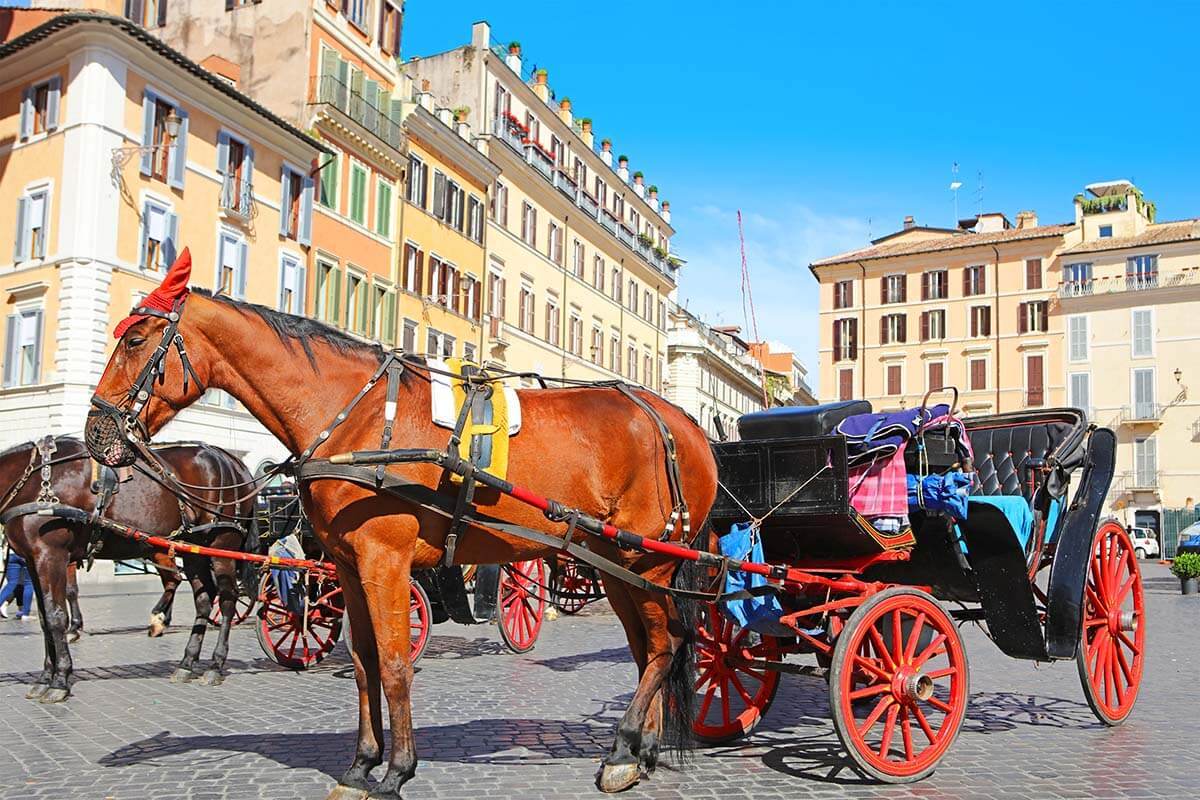
Visiting Rome, Italy, and looking for essential Rome travel tips? This guide is packed with practical, experience-based advice to make the most of your trip and help you enjoy the city to the fullest.
From the best time to visit and where to stay, to must-know sightseeing tips for the top attractions, dining recommendations, and even what shoes to wear – in this article, we cover everything you need to know when planning a trip to Rome.
This post is regularly updated based on our latest trips to Rome to ensure you get the most up-to-date, real-world tips. I hope it helps you plan an amazing and memorable trip to the Eternal City.
Good to know: 2025 is a Jubilee Year in Rome. It’s the Vatican’s Holy Year, celebrated once every 25 years, and it attracts pilgrims from all over the world. So the city will be busier than ever before. Planning ahead is absolutely essential if visiting Rome in 2025!
Where to Stay: For the best experience and convenient access to the top sights, stay in the historic city center – ideally around the Pantheon, more or less between the Trevi Fountain and Piazza Navona. Some of our favorites on a mid-level budget in this area include 9Hotel Cesari (fantastic rooftop terrace for breakfast), Trevi Beau (a highly rated boutique hotel), and Hotel Barrett (very unique decorations – you either love it or not so much ;)).
READ ALSO: Where to Stay in Rome
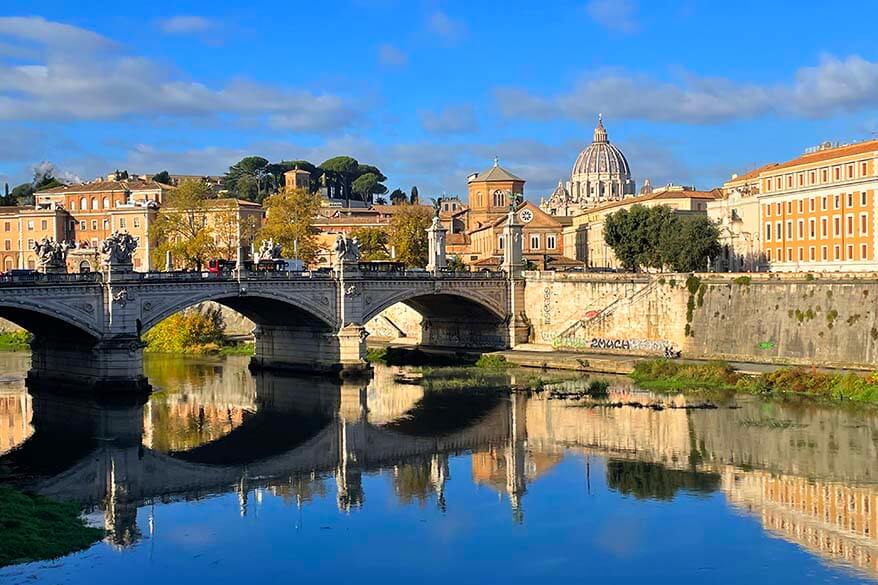
Rome is not only one of the most beautiful cities in Italy but also one of the most impressive in the world! I often call it a city-museum because simply walking through its streets feels like stepping through history. Every building, every church, every square has a story to tell. With so much to see and do, Rome is a city like no other – a place everyone should visit at least once in their lifetime.
But let’s be honest – Rome is crowded. It often feels like everyone is visiting at the same time as you! The city’s most famous sights, like the Trevi Fountain, can be overwhelming during peak hours, making other popular destinations seem peaceful in comparison.
The good news? There are ways to make your trip more enjoyable. Below, you’ll find my top tips for experiencing Rome to the fullest – without letting the crowds get in the way. Read on!
READ ALSO: Best Things to Do in Rome

Here are our top Rome travel tips:
1. Book in Advance
When traveling to Rome for the first time, you probably have a good idea of what you want to see – the Trevi Fountain, the Pantheon, the Colosseum, the Roman Forum, the Vatican… However, you’ll quickly realize you’re not the only one. Rome’s most famous landmarks draw massive crowds, and if you don’t book tickets in advance, you may not be able to visit at all.
The same goes for accommodations – book early for the best availability and prices, or you may end up staying on the outskirts of town and still paying a fortune (more about this further below).
The Colosseum and Vatican Museums – the two most in-demand attractions – often sell out weeks ahead. If you want to visit the gladiator arena or see the famous Sistine Chapel, you must reserve early! That said, we recommend making reservations for everything you really don’t want to miss – whether it’s the main landmarks like the Colosseum or the Pantheon or experiences like food- or bike tours.
- High season (mid-March to mid-November):
- For the Colosseum, book tickets as soon as they are released (typically 30 days in advance) or reserve a tour as soon as you know your travel dates (we recommend going with a guide – more about it further below).
- For the Sistine Chapel (Vatican Museums) – get your tickets at least 3-4 weeks in advance. For a better experience, see if you can secure a spot on this amazing early-access tour.
- St. Peter’s Basilica can be visited free of charge, but you can reserve the Dome climb in advance.
- For the Pantheon, reserve fast-track tickets online!
- Borghese Gallery – book tickets ahead!
- Be sure to book airport transfers online as well – it will save you lots of stress upon arrival.
- Low season (winter): You will find last-minute availability for less popular places, but don’t count on last-minute tickets for the main sights. We recommend making reservations for everything you absolutely want to see.
Good to know: Keep in mind that the Vatican Museums sometimes close for religious events. Booking in advance lets you see availability upfront, so you can adjust your itinerary if needed. Otherwise, you risk missing out.
PRO TIP: If tickets are sold out, you can often still visit even the most popular places by booking a guided tour. Many tour operators have access to these places even when individual tickets aren’t available. (More info on tours below.) Whatever you do, don’t buy tickets from random sellers on the street – not only will you pay multiple times the price, but you also risk not being able to visit if the ticket is in someone else’s name.
READ ALSO: How to Visit Colosseum in Rome (all levels and tickets explained)
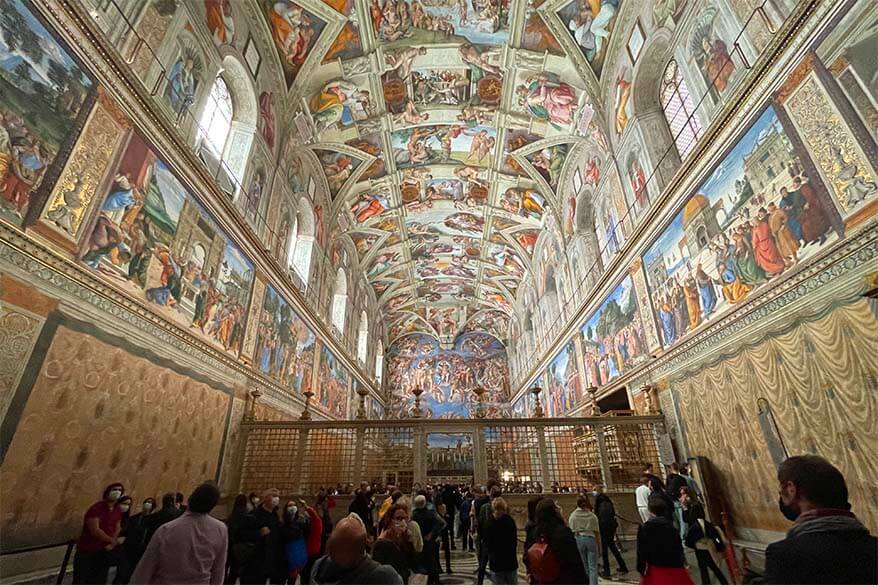

2. Join Guided Tours for a Better Experience
If you’re like most visitors, you only have a few days in Rome and want to see as much as possible. But do you really want to spend hours standing in line at the city’s top landmarks—only to feel rushed, lost, or overwhelmed once you’re inside?
Booking a guided tour is one of the best ways to maximize your time and experience Rome’s history and culture without the hassle. With an expert guide leading the way, you’ll skip long lines, gain deeper insights, and navigate the crowds with ease. Instead of worrying about where to go, you can focus on enjoying the sights and stories that make Rome so special.
Many of Rome’s sights are vast and overwhelming, and it’s often hard to know exactly where to go, what’s most worthwhile, or how to navigate it all. I’ve never heard anyone regret taking a tour, but I’ve heard plenty of people frustrated by trying to figure it out on their own, especially at the Colosseum and the Vatican.
Sure, tours cost a little extra, but compared to the overall cost of your trip, they’re a small investment for a far more rewarding experience. So if you don’t want to spend your valuable time waiting in lines or figuring out the logistics, do yourself a favor and book a tour.
Our Experience: The first time we visited the Vatican Museums, we went on our own – and it was overwhelming and stressful (and that was years ago when Rome was much quieter than it is today!). Since all routes eventually lead to the Sistine Chapel, we did make it there, but it wasn’t until we returned with a guide that we realized just how much we had missed.
The same goes for the Colosseum and the Roman Forum – without the stories behind them, they’re just a collection of ruins. A guide truly brings these places to life! Plus, Rome’s archaeological sites are so vast that without direction, you can easily lose hours just wandering aimlessly. We now always book guided tours when visiting Rome – and not just for the most popular sights!
Here are some of our personal favorite tours in Rome:
- The Colosseum: Colosseum Underground Tour (regular levels are always included).
- Sistine Chapel & the Vatican Museums: Early-morning Sistine Chapel Tour.
- Food: Trastevere or Jewish Quarter Street Food Tour.
- Off the beaten path: Appian Way, Aqueducts & Catacombs.
- Any tour with Walks is a great choice. We love their small-group tours with expert local guides – I’ve lost count of how many we’ve taken over the years, and not just in Rome! The Sistine Chapel tour mentioned above is also run by them, and they offer several other fantastic options, some with exclusive access. Definitely check them out!
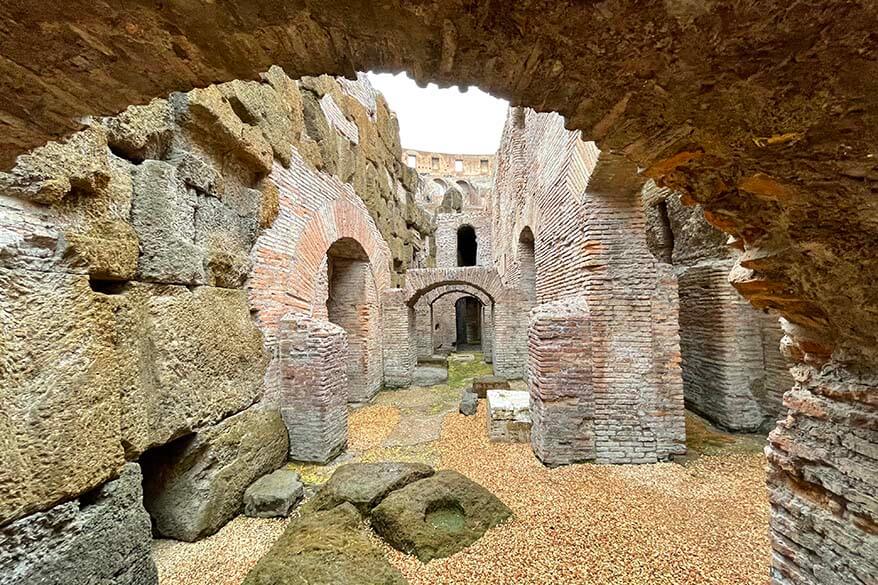
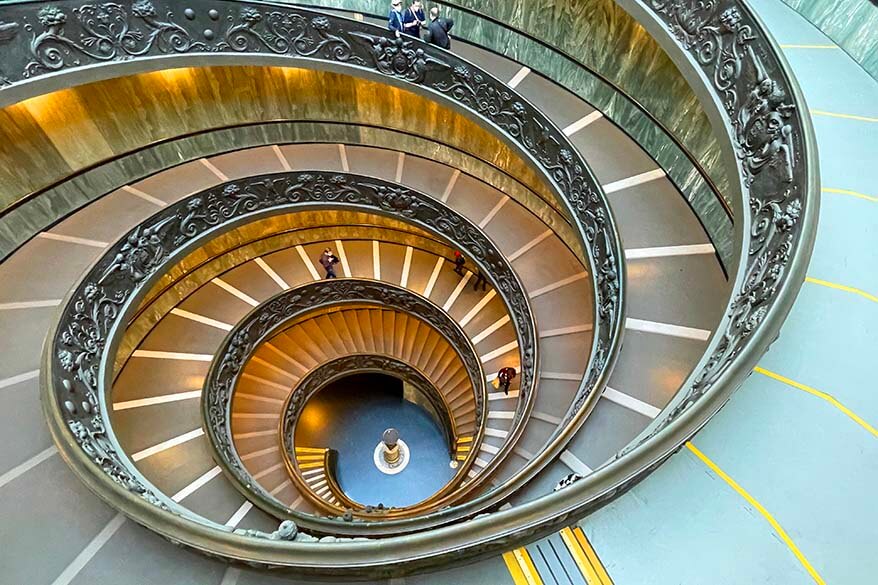
3. Outsmart the Crowds
Planning a trip to Rome and worried about crowds? The good news is that you can enjoy the city’s top landmarks without the masses – if you plan wisely. The best way? Visit during less popular times. I have to be honest with you, though – this is easier said and done, especially if you are visiting in the peak season.
TIP: For fewer crowds, travel in the low season (November–March) – more info about that later. But even in peak season, timing makes all the difference. Mornings are best for some sights, while afternoons work better for others. Here are some examples and tips for visiting some of the most popular landmarks in Rome.
Best Time to Visit the Trevi Fountain
To experience the Trevi Fountain without the crowds, arrive early – no later than 7-7.30 AM. This is the best/only time to enjoy the fountain with fewer people around. However, even mornings can get busy, especially in the summer season.
Alternatively, visit late in the evening. While there will still be some people, the crowds will be much smaller compared to daytime hours.
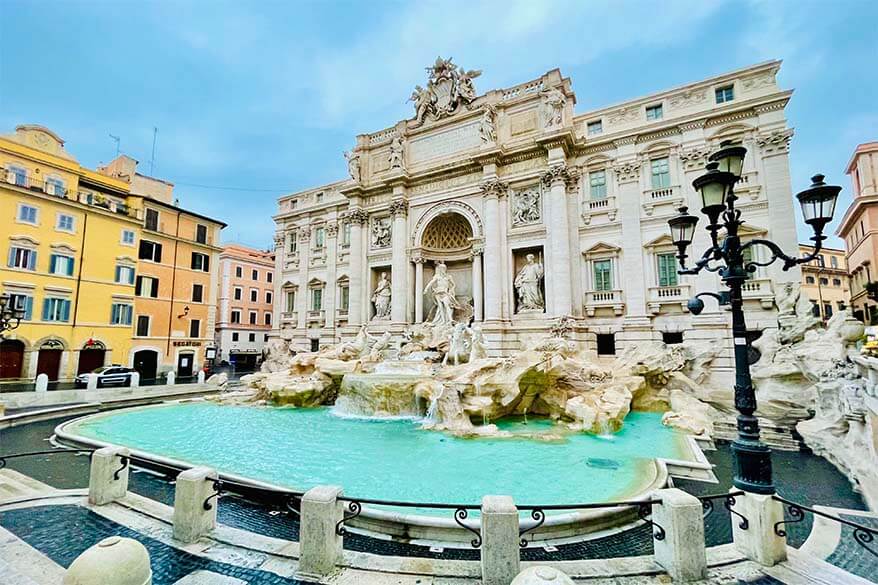
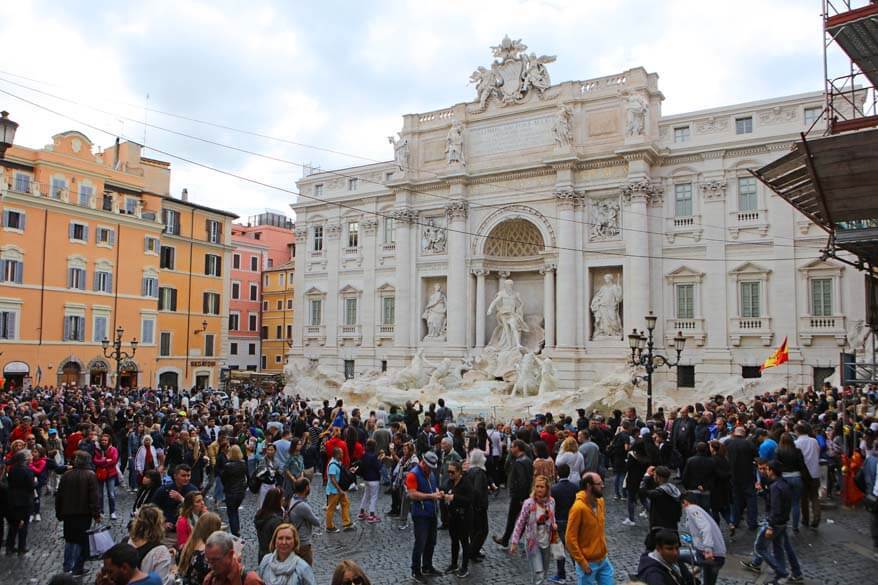
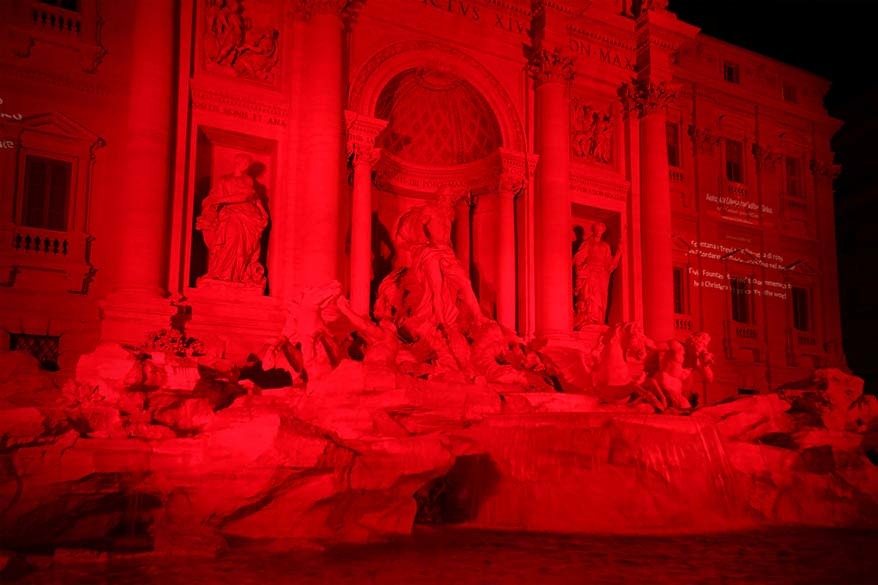
Best Time to Visit the Vatican
To avoid the biggest crowds at the Vatican, visit either early in the morning or late in the afternoon. Midday (10 AM to 3 PM) is always the busiest.
That said, while the Vatican Museums are best visited first thing in the morning, St. Peter’s Basilica is usually at its quietest in the late afternoon, an hour before the closing time. Since you will likely want to see both on the same day, you won’t be able to avoid the crowds altogether.
Since St. Peter’s Basilica is free to visit and doesn’t require tickets, we recommend starting at the Sistine Chapel – ideally, with an early-morning tour like this one. For St. Peter’s Dome, you can buy tickets on-site, but it is also possible to reserve tickets with assisted entry online (choose the elevator option – there will still be more than plenty of stairs to climb at the top!).
TIP: We recently took this Basilica tour that included the Dome Climb and it was really good. If you are not booking a guided tour at the Sistine Chapel, consider this one. We had been to St. Peter’s countless times before and still learned a lot.
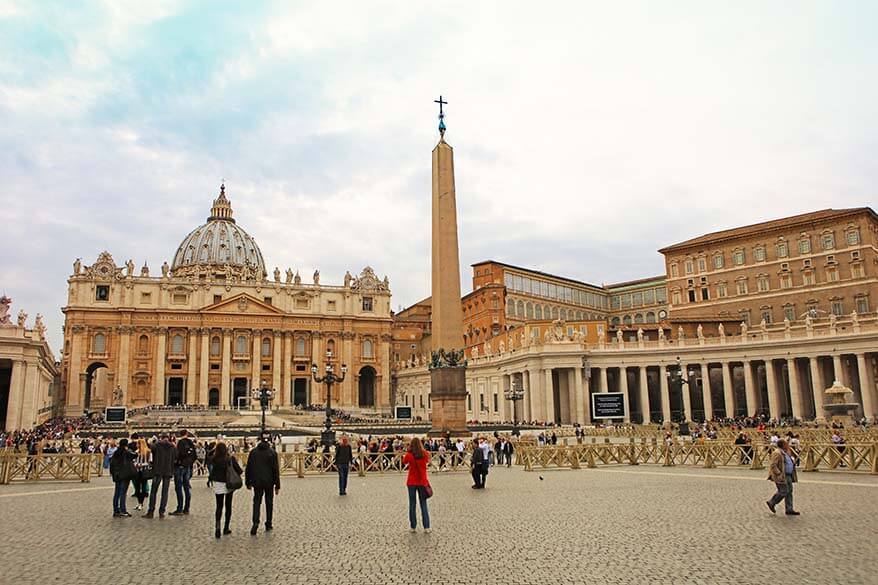
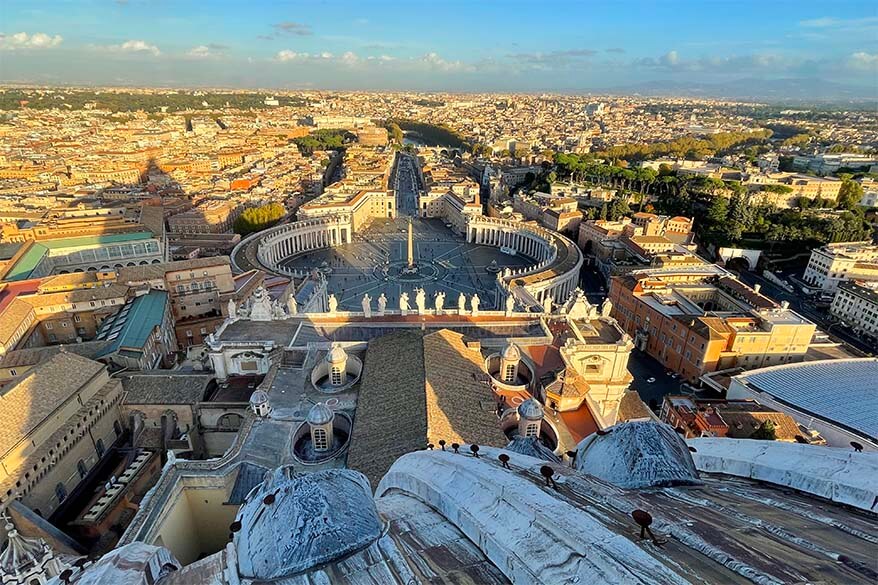
When to Visit the Pantheon
The Pantheon now requires a timed ticket, which can be purchased online. To avoid long queues in the sun, we highly recommend booking in advance!
For fewer crowds, aim for the first time slot in the morning or visit about 30 minutes before closing. We once had the Pantheon completely to ourselves just before closing – an unforgettable experience! Just be sure not to arrive too late, as they stop admitting visitors half an hour before closing time.
TIP: All online tickets include an audio guide, offering an insightful overview of the Pantheon’s history and architecture. You need about half an hour for a full visit with the complete narrative.
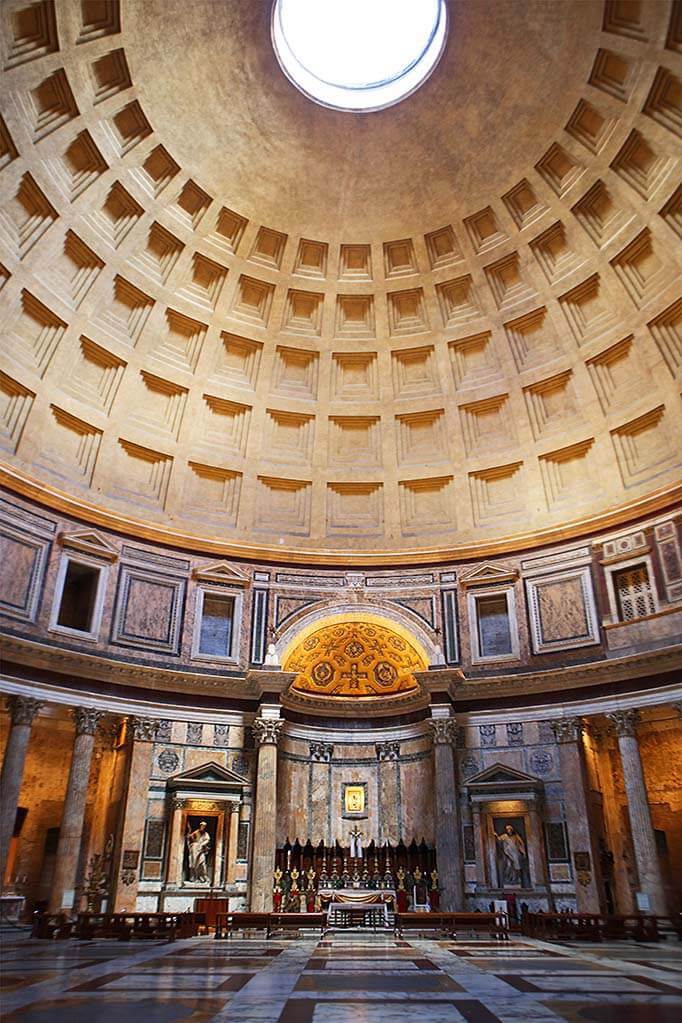
Best Time to Visit the Spanish Steps, Piazza Navona & Other Landmarks
The Spanish Steps are best visited early in the morning or late at night, as they’re usually crowded during the day – often so much so that you can’t even see the steps through the crowds.
The same goes for Piazza Navona. While the square is peaceful in the morning and late evening, it becomes very crowded during the day.
If you’re short on time in Rome and want to avoid the crowds, skip the busiest museums to save hours. The Capitoline Museums, for example, have no designated entry times and are almost always crowded, with long queues at the entrance.
For art lovers, consider visiting (somewhat) quieter spots like Villa Borghese or Doria Pamphili Gallery. Alternatively, explore some of Rome’s churches, where you can admire incredible works of art for free and without the crowds.


4. Stay Close to the Pantheon
If your budget allows, consider staying in the heart of Rome, near the Pantheon. This area, between Piazza Navona and Trevi Fountain, offers the best location—right in the center of everything.
We always stay close to the Pantheon on our trips. Its central location makes it easy to walk to all the major landmarks, so you won’t need public transport.
Staying here lets you explore central Rome on foot, with the added bonus of visiting popular spots early in the morning before the crowds arrive. Imagine strolling to Trevi Fountain, the Pantheon, or the Spanish Steps at sunrise, then returning to your hotel for a relaxing breakfast – it’s the perfect way to start your day in Rome.
Here are some hand-picked hotel recommendations in this area for all budgets:
- €€€€€ Eitch Borromini Palazzo Pamphilj– Stunning location overlooking Piazza Navona.
- €€€€ 9HotelCesari – You’ll love having breakfast on the rooftop terrace!
- €€€ Albergo Abruzzi – Very highly rated 3* hotel close to the Pantheon.
- €€ Navona Theatre Hotel – Great value for money at a fantastic location.
- €+ Hotel Primavera – Very popular 2* hotel offering excellent value.
READ ALSO: Where to Stay in Rome: Best Area & Hotels
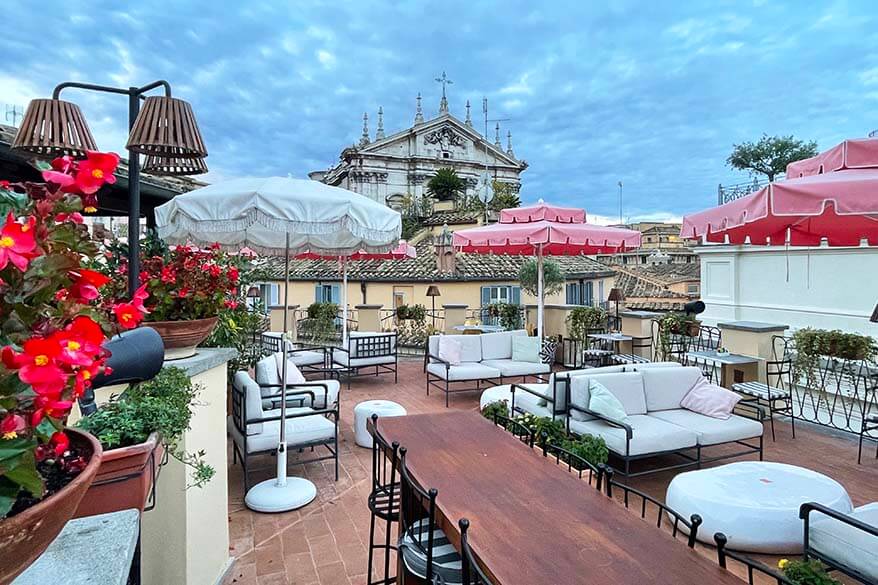
TIP: There are so many hotels, B&Bs, and short-term rental accommodations in the center of Rome that it would be impossible to highlight all the best options. A lot also depends on your exact travel dates. Using the map below, you can compare various accommodation providers in one place and find the best deals for your trip.
Simply insert your travel dates and group size and you will see what’s available in the area of your choice. Check it out!
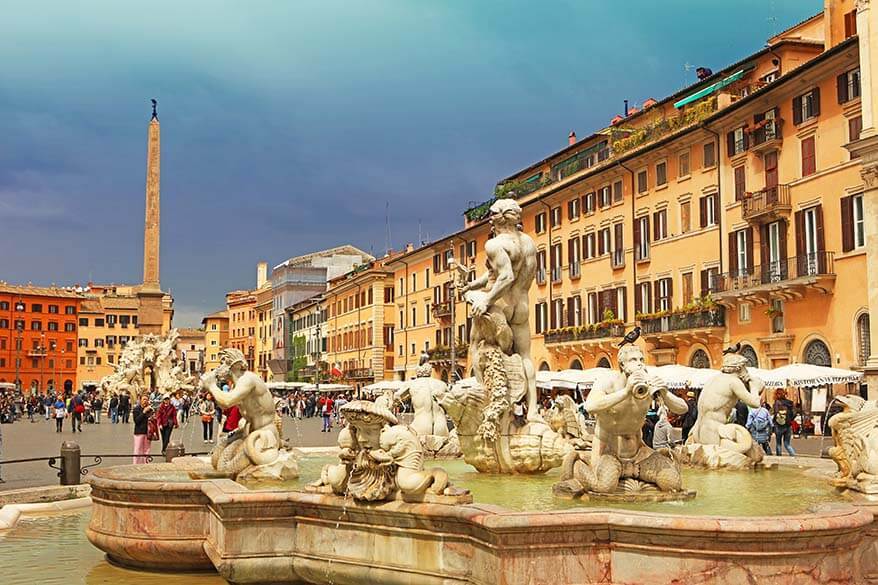
5. Research & Book Airport Transfers in Advance
If you are arriving in Rome by plane, you’ll most likely land at the Fiumicino Airport, aka Leonardo da Vinci International Airport. This airport is located about 30 kilometers (18.5 miles) outside the city center and the drive usually takes about 35-45 minutes.
Ciampino Airport is about 15 kilometers (9 miles) from the center, but the drive usually takes almost just as long – over half an hour.
There are many ways to get to the city center from these airports. The best option depends on where you are staying, at what time of day you arrive, and, of course, your budget. Either way, you will save time and money by doing some research and booking in advance!
Here are the best Rome airport transport options:
- The easiest way to get from any airport directly to your hotel in Rome is by booking a private transfer. Alternatively, you can take a taxi. The rates are now fixed by the city – to avoid tourist scams. However, depending on the time of the day, traffic can be busy, not even to mention that there is often a long wait for a taxi (for that, a private transfer is better).
- The fastest, most reliable, and most convenient way to get to Rome city center from Fiumicino airport is by train – Leonardo Express. Trains run every 15-20 minutes from early morning to almost midnight. You get a digital ticket that is valid for any train on the selected day, so you don’t have to worry about having to look for a ticket desk or stress in case your flight is delayed. Also, there are no luggage limits. Round-trip tickets are also available.
- The cheapest way to travel between Fiumicino Airport and the city center is by shuttle bus. Some buses go straight to Rome Termini Central Station, while others also have a stop near the Vatican There are also shuttle bus transfers to/from Ciampino Airport.
LEARN MORE: Rome Airport Transfers: Complete Guide for Fiumicino & Ciampino
6. Get Off the Beaten Path
If I can offer one piece of advice to avoid the crowds in Rome, it’s this: go in the opposite direction of where everyone else is headed. Wander down side streets, explore narrow passages, or try the door of a closed church – sometimes the best discoveries are just steps away from the busy main roads.
We’ve found hidden gems just meters away from the crowded streets, where thousands of people rush by, oblivious to the quieter, more peaceful spots.
Check out our guides for some of Rome’s underground sites, lesser-known Ancient Rome landmarks, and the best views in the city – many of which are hardly ever visited.
You can also explore more off-the-beaten-path places to see in our detailed guide below.
LEARN MORE: Hidden Gems of Rome
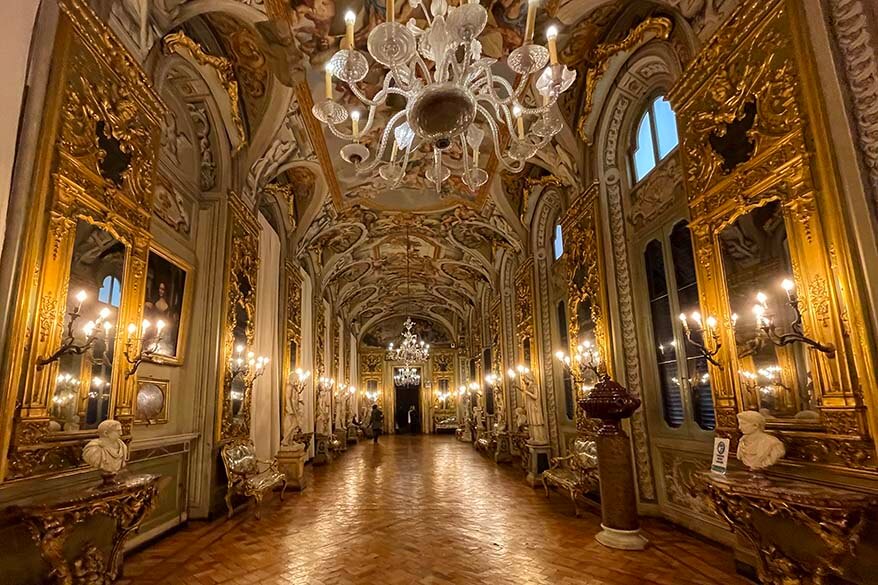
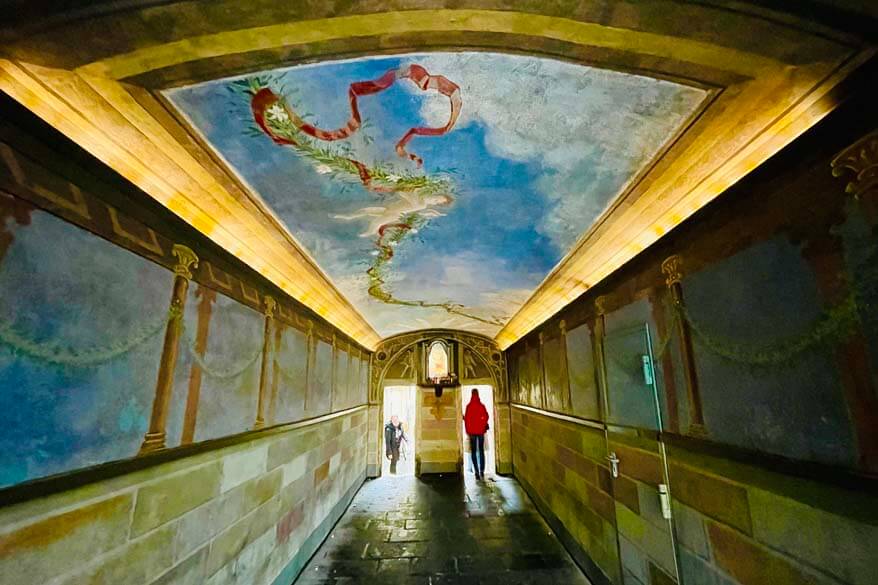
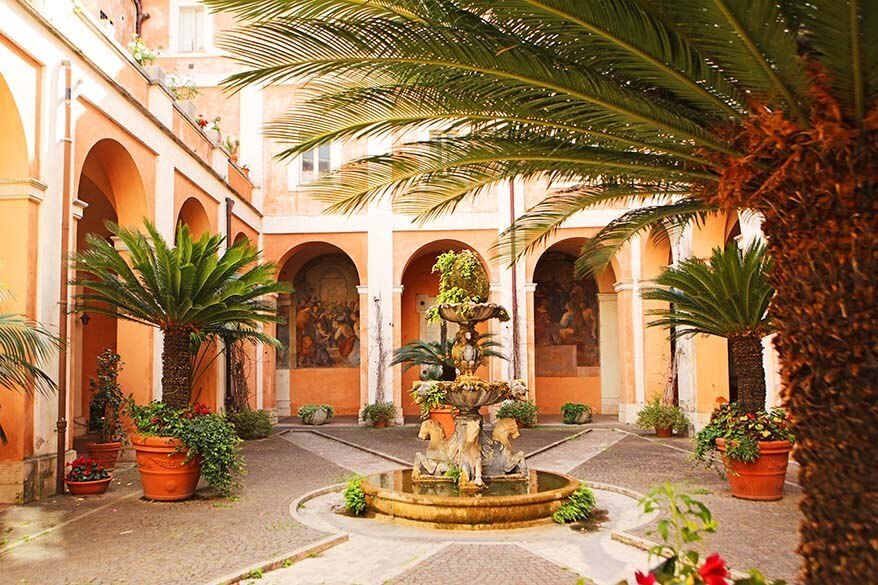
7. Avoid Tourist Restaurants
Food is a major part of any Italian trip, but don’t assume the best meals will be everywhere you go.
My top piece of advice for eating in Rome? Avoid touristy spots. Restaurants near landmarks like Piazza Navona, the Pantheon, or Campo de’ Fiori often serve overpriced, underwhelming food – look for places where locals eat instead, and steer clear of menus with pictures.
If you’re not sure where to eat, ask your hotel for suggestions, but be aware that they might recommend places for other reasons than quality. A better option is to check Google Maps reviews to avoid tourist traps.
TIP: A great way to discover authentic local flavors is by joining a food tour or a cooking class early in your trip. Be sure to also ask your tour guide for some insider recommendations for excellent places to eat.
On our last trip to Rome, we booked this amazing street food tour. Not only it was a great way to learn the more local side of Rome, but we also tried some absolutely delicious food and got plenty of restaurant ideas for the rest of our stay. Here you can find our review of this street food tour in Rome. Highly recommended!
LEARN MORE:
How to Find the Best Food in Rome
Best Traditional Food in Italy
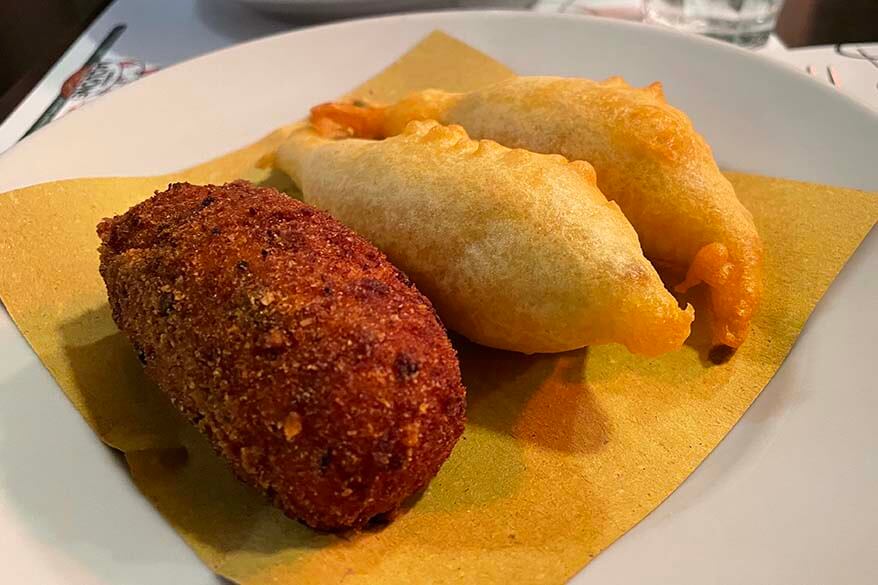

8. Bring Some Cash
While credit cards and electronic payments are now widely accepted in Rome, it’s still a good idea to carry some cash for certain situations when visiting Rome (or anywhere in Italy, for that matter). Italy uses Euros, so make sure you have a few on hand.
Taxis, however, are notorious for rejecting credit cards (‘machine no work’ ;)). So always have enough cash for a taxi ride, as many drivers prefer cash payments. We encountered this issue when taking a taxi from the airport and with a hotel-arranged private transfer. If you don’t want to use cash for airport transfers, you can easily book them online in advance. Often, it’s also cheaper.
You’ll also need cash for street vendors, souvenir shops, and local markets, as many of them don’t accept cards.
For tipping, it’s not mandatory in Europe, but it’s appreciated. We typically leave around 10% at restaurants and give small tips to tour guides.
But apart from this, you can pay for pretty much everything by card. Credit/debit cards are accepted even for small purchases like gelatos.
TIP: To stay on the safe side, carry about 50-100 EUR in small notes and leave the rest at your hotel (in the safe). I also recommend not carrying all your payment cards with you.
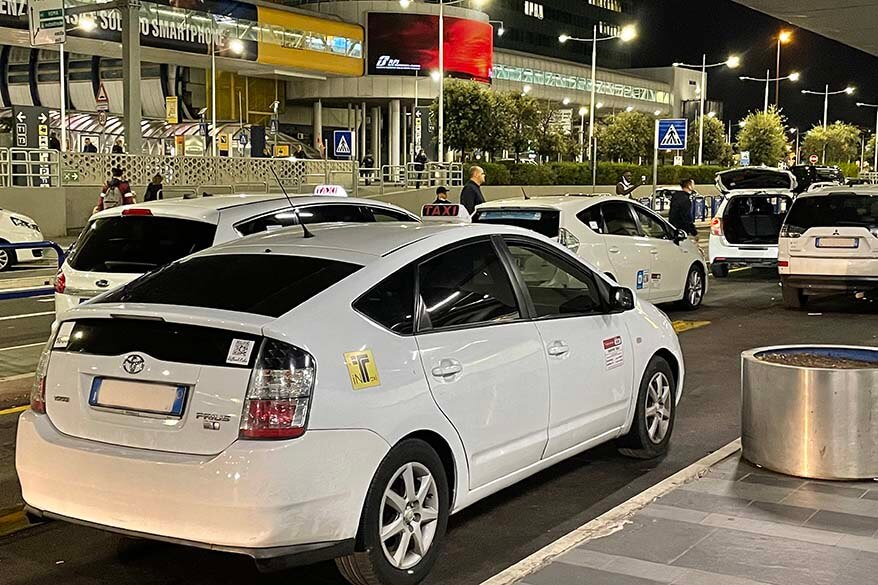
9. Take a Bike (Tour)
The old city center of Rome is pretty compact. You can easily walk to the main sights such as Piazza Navona, Pantheon, The Trevi Fountain, and the Spanish Steps. Even the Vatican and the Colosseum are within walking distance from the city center.
However, if you want to explore more of Rome and discover some of the less-known hidden gems of the city, consider renting a bike or joining one of the many guided bike tours. By bike, you can cover bigger distances in less time and get more out of your time.
We recommend tours – bicycling in Rome is hectic and it’s only fun if you know the city well and know where exactly to go. Guided tours follow routes that they have tried and tested many times before allowing you to truly enjoy the experience.
TIP: If you opt to explore Rome by bike, opt for e-bikes. It’s a hilly city – an electric bike will make it so much more enjoyable! This is one of the best-rated bike tours of the highlights in the city center. And this is the AMAZING off-the-beaten-path bike tour that we recently did in Rome (highly recommend).
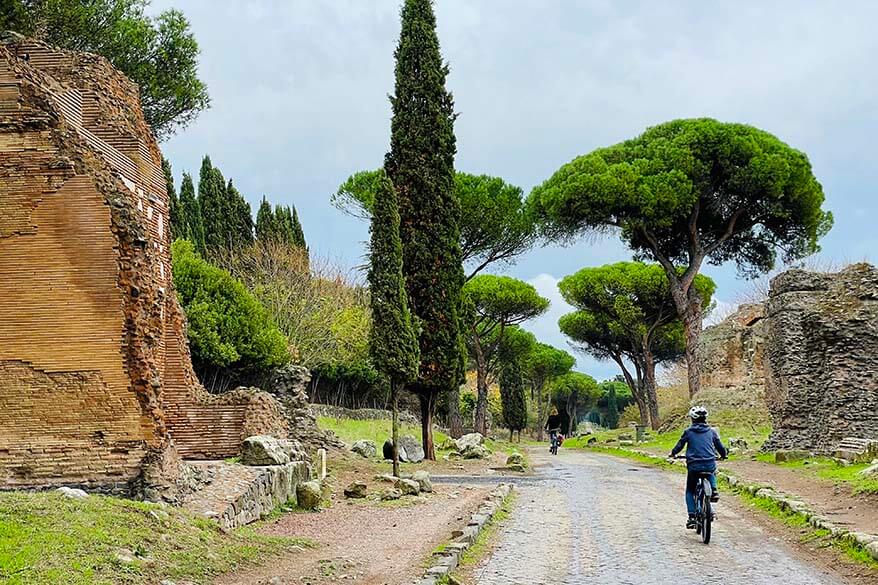

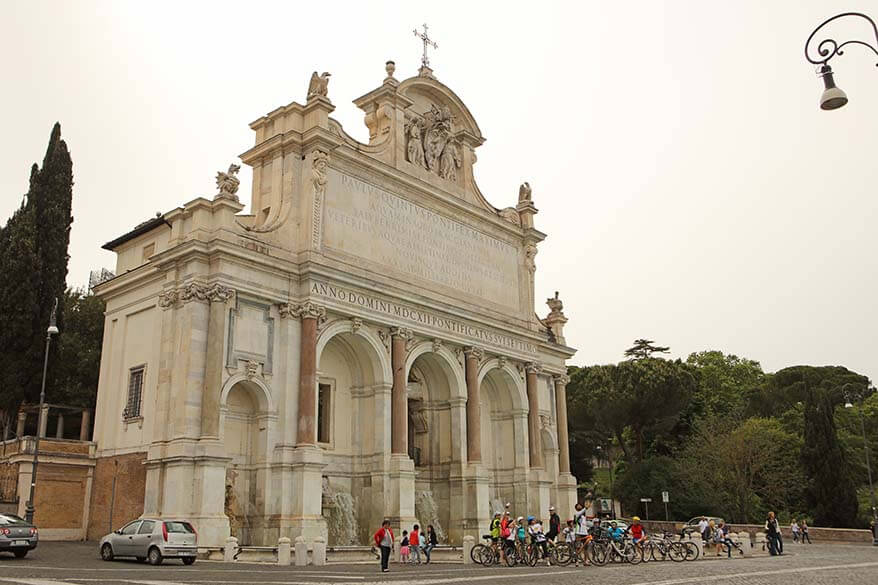
10. Visit Rome in the Off-Season
Most travel guides will probably tell you that spring and early autumn are the best times to visit Rome for great weather (April-May and late September-October), but they’re also the busiest months. To avoid large crowds, consider visiting during the cooler months.
Summer in Rome is best avoided due to extreme heat, with temperatures often surpassing 35°C (95°F), and the city feeling more like a theme park as locals leave for vacation.
Once we visited Rome the first weekend of May and with temperatures of just 18-22°C (64-72°F). It was pleasant most of the time and sometimes it even felt too warm.
Another time, we were in Rome at the end of September and it was still hot during the day. I cannot even try to imagine how hot it feels there in July or August.
Our most recent visit to Rome was in early November, and the weather was perfect for sightseeing – around 20°C (68°F), with a few showers. While it’s still busy at the main landmarks, crowds are smaller than in peak season, and accommodation is more affordable.
For fewer crowds, cooler weather, and cheaper rates, try visiting in the shoulder season – late March to early April (but avoid Easter!) or early November (but avoid the weekend around November 1 as it’s a public holiday in many European countries).
Overall, November is a pretty good month to visit the main cities in Italy – the weather is usually pleasant and the crowds are very manageable. Here you can read about what it’s like to visit Italy in November and here – what to expect when visiting Rome in November.
I recently visited Venice in December and loved it too. It’s colder, but there are no crowds whatsoever – imagine that!
READ ALSO: Best Time to Visit Europe
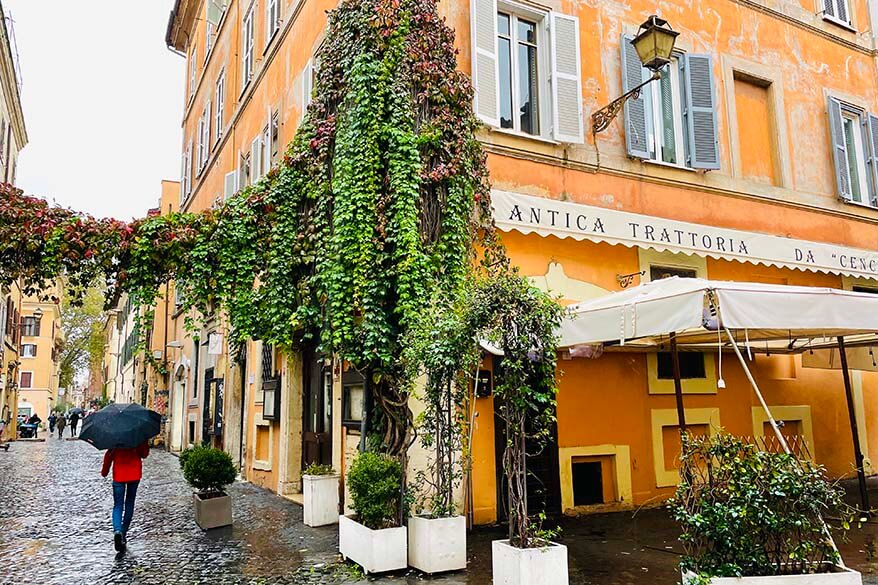

11. Wear Comfortable Shoes & Dress Respectably
One of the most important tips for visiting Rome: wear comfortable shoes!
Rome is a very walkable city, and you’ll be doing a lot of walking. The cobblestone streets and long distances can take a toll on your feet, so prioritize comfort over style. Forget about trying to look trendy – opt for sturdy, comfortable sneakers rather than sandals with thin soles.
You’ll notice that those still smiling at the end of the day are usually the ones with the best footwear. Fortunately, stylish and comfortable shoes are easy to find these days, so you don’t have to sacrifice comfort for looks.
Also, when visiting churches or the Vatican, make sure your shoulders are covered and avoid wearing shorts, mini skirts, or sleeveless shirts. Respectful attire is required to enter these sites.
READ ALSO: Most Beautiful Churches in Italy (+ Tips for Visiting)

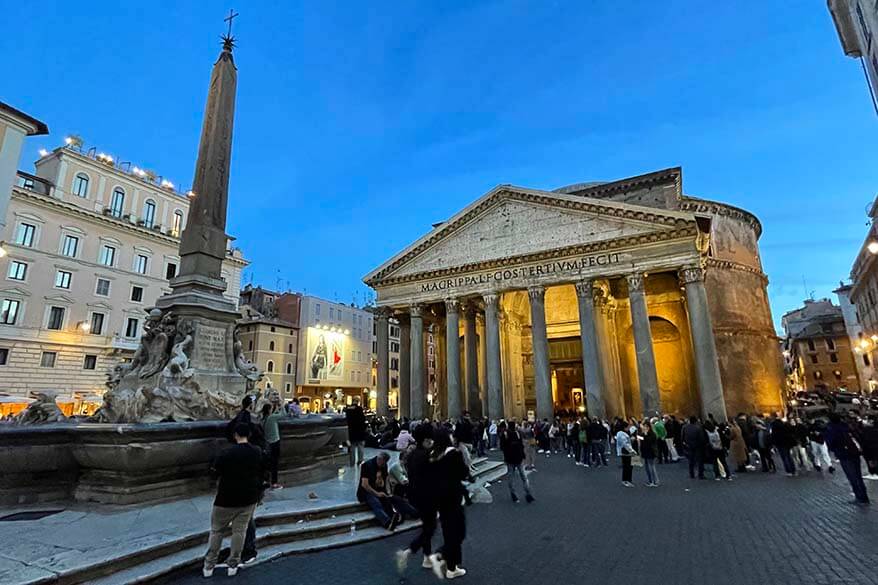
12. Pack a Water Bottle
No matter when you visit Rome – – in summer or in winter – always carry a water bottle with you. While you can buy bottled water, there’s no need to waste money or use unnecessary plastic.
There are more than 2,500 drinking fountains in Rome. The water is fresh, cold, always available, and it’s completely free of charge.
So, pack a reusable bottle and take advantage of these fountains throughout the city!
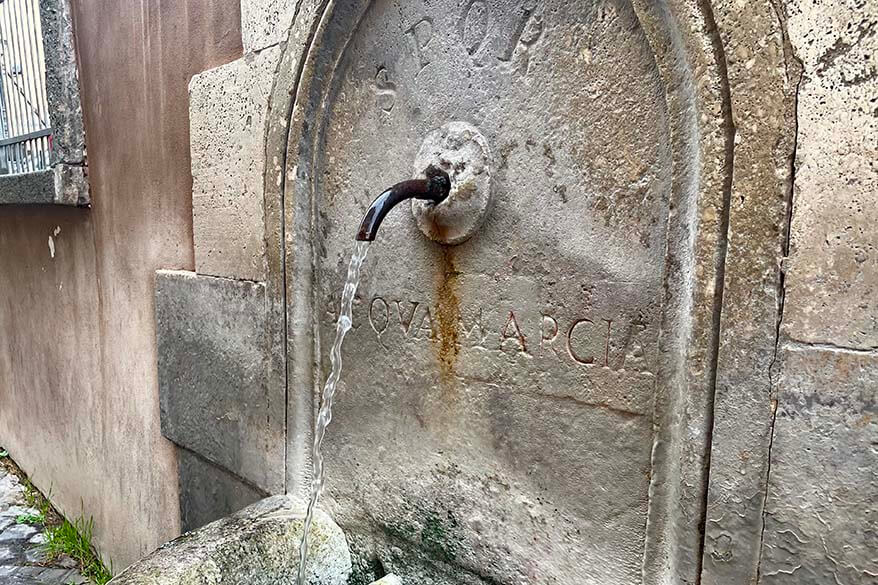
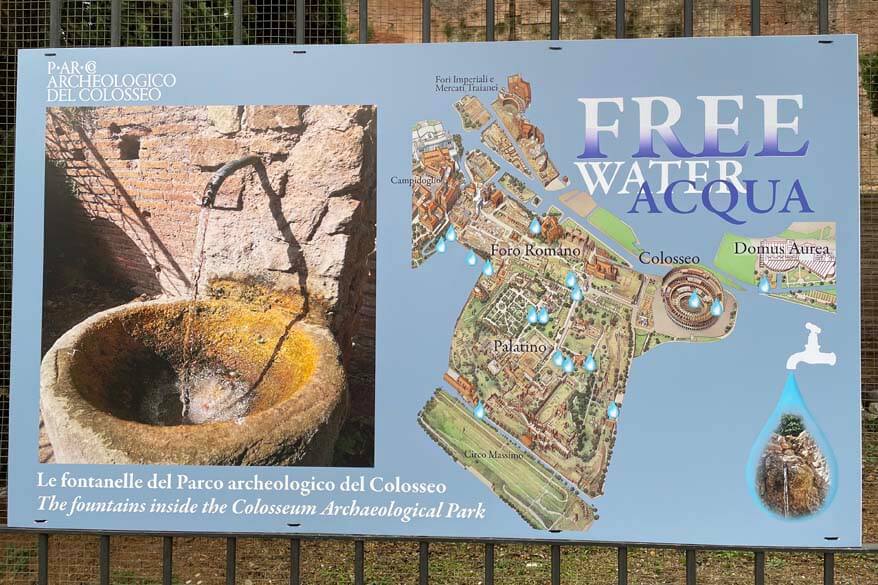
13. Prepare a Good Itinerary but Don’t Overplan
Here’s one last piece of advice for visiting Rome – especially if you’re staying for more than just a day or two – avoid planning every minute of your day,
While it’s essential to have a general itinerary and book tickets for key attractions in advance (to avoid wasting time or missing out), leave room for spontaneity. Allow yourself time to wander off the beaten path and explore hidden gems that you’ll discover along the way.
Look around, and you’ll be amazed by the beautiful churches, stunning architecture, secret alleys, and charming squares.
The best experiences often come from being open to the unexpected. Enjoy your adventure in Rome!
Suggested itineraries:
- Rome in a Day (how to see all the musts in just 1 day)
- Rome in 2 Days (all the best places + a few hidden gems)
- 4 Days in Rome (amazing itinerary that covers all the main landmarks & and lots of hidden gems)
- You may also like to read our 2-week Italy Itinerary. It covers all the musts in the most efficient way.
READ ALSO: Best Places to See in Italy
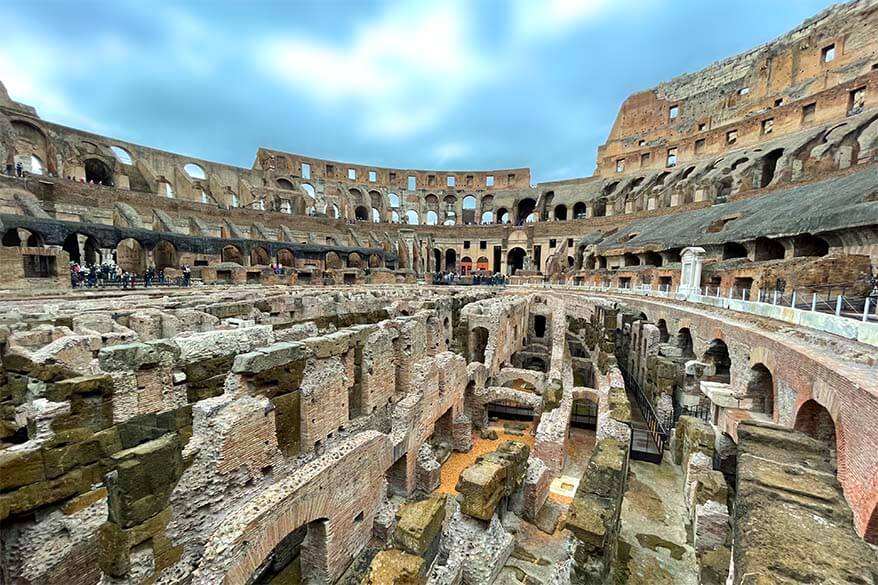
These essential tips will help you make the most of your trip to Rome. Visiting the Eternal City is an unforgettable experience, and with a little planning, you’ll be able to fully enjoy all that this incredible city has to offer.
Have a great time in Rome!
TIP: We have been to Italy countless times and have tons of articles covering many destinations all over the country. Check out our Italy travel guide for city guides, itineraries, and travel tips for the most popular cities, lakes, mountains, and coastal towns.
If you found this post helpful, don’t forget to bookmark it and share it with your friends. Are you on Pinterest? Pin this image!
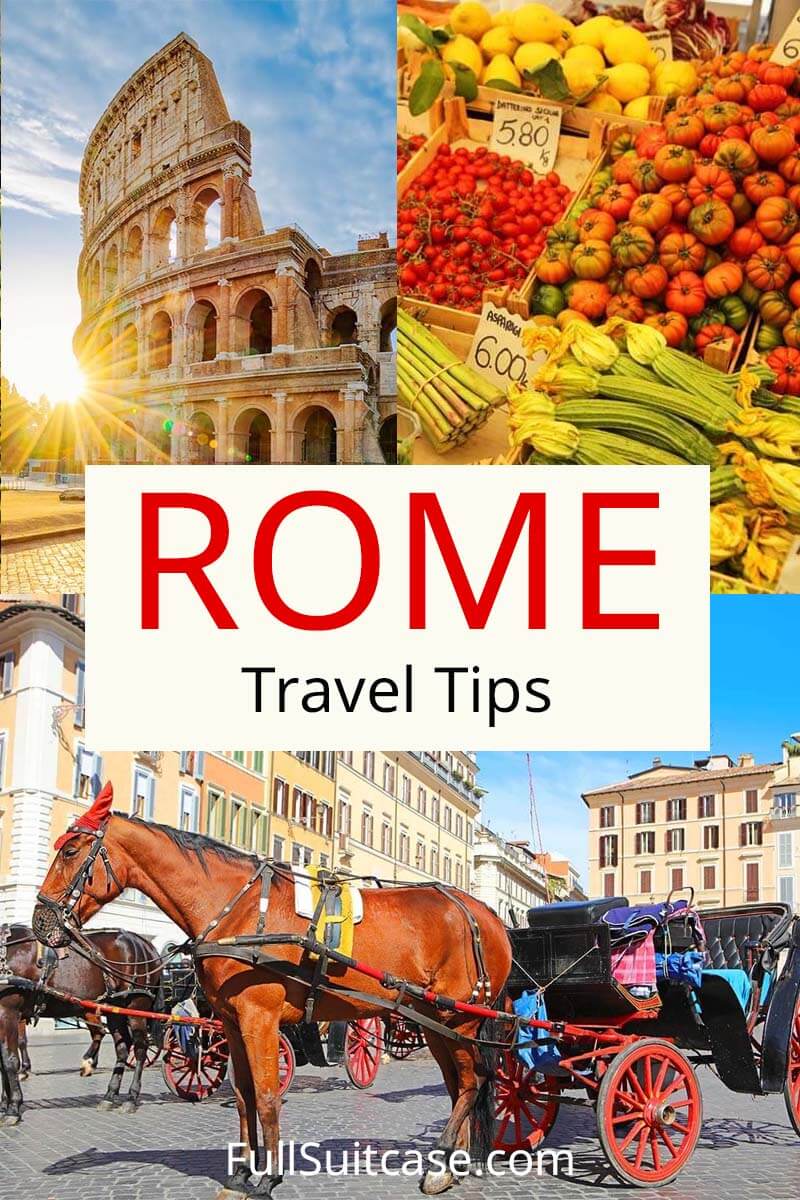
This site contains affiliate links, which means that we may earn a small commission, at no cost to you, for qualifying purchases. More info: Disclosure.

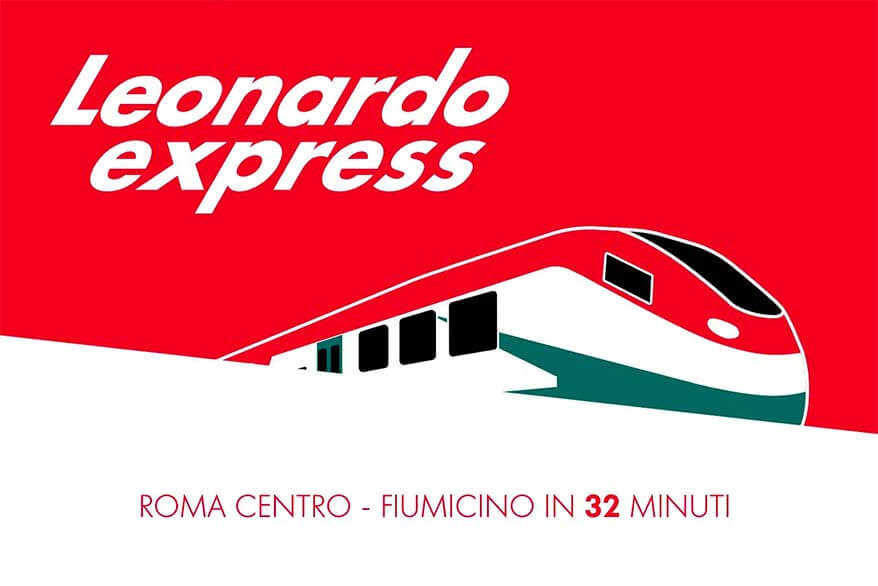





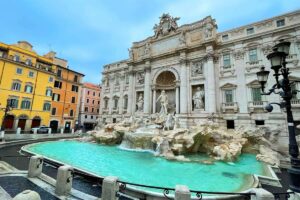

Ostia Antica an archaeological site 25 km south of Rome well worth a visit as well. Ostia is presently well known for its beaches and seafood. More than 2,000 years ago it was Rome’s busy seaport and naval base, a community of 100,000 souls, but declined because of marshy conditions.
If you can’t make it to Pompeii, it is more than a reasonable alternative. There are extensive well preserved ruins, frescoes and mosaics spread over a wide area. Spend a morning or afternoon. Check it out.
Hi Julius, yes, it’s a very interesting site- like so many in Italy! We actually have written about it in our guide of the best ancient Roman sites to visit in Rome.
There’s just so much to see!
Thanks for sharing and happy travels!
Rome is breathtaking! Thanks for the tips. We had a great trip!
Glad to help, Lina. Happy travels!
Thank you for all of this info! We’re headed in July. Question for a nervous nelly traveling all day – what about public restrooms? We will be on a train morning and night from Florence, so I’ll at least have access to that 🙂 Thanks in advance!
There are bathrooms at all the main tourist attractions and also at most restaurants. It never really struck me as something that wasn’t readily available, but as I always say to my kids ‘use it when you get the chance’.
Hi Jurga,
Thank you for the indepth insights. It is wonderful.
Any know abouts to consider if traveling with toddler and infants? Is it convenient to take a stroller every where ?
Thank you.
Hi Noshir, the historic center of Rome is rather flat but there are cobbled stones everywhere. And the moment you leave the center, there are also some hills – like the Spanish Steps, for example. So it’s not a straightforward answer. You will be able to visit many places with a stroller (with big wheels that can handle cobbled streets), but there are also many places where it won’t be easy. Like the Colosseum, for example – you can walk around it with a stroller, but visiting inside won’t be easy.
That said, we have been to other hillier places in Italy when our kids were in strollers and we managed (with three kids and two strollers – one of them double). But you have to do a bit more research for every place you want to visit. There’s also a huge difference when you travel with just one kid/stroller or a couple of young kids and a few strollers.
One tip – pack a bicycle lock with you. So that if you have to leave the strollers somewhere, you can lock them up.
@Jurga,
Thank you very much.
The tip to carry lock is great !!
Regards,
Noshir
Sorry Jurga, me again,
We are planing on staying 4 days in Rome, visit the main landmarks, I just can’t make up my mind if we should get the Rome Tourist Card or just book individually for each one of those.
Thank you,
Liviu
Hi Liviu, if you mean this Rome Tourist Card, then it has pretty much the same advantages as booking everything individually, but normally, it’s a bit cheaper AND you get to choose all tickets/time slots in one place. So it’s very convenient, if you want to visit all those places anyway.
If, however, you would like to book a guided tour at e.g. Colosseum, then it’s better to book individual tickets for the other attractions. But if you are just looking for tickets and want to visit everything on your own, then you can just as well book everything in one go.
Hope this helps. Have a great trip!
Hi Jurga,
Most comprehensive guide, congratulation and thank you.
Liviu
Hello Jurga
Thank you so much for providing a lot of useful information , Italy is my dream destination ever since , my husband and i are planning to visit Rome next month
Is it a good time to travel in March?
Hi Diki, Rome is always a good idea and March is a very nice month for sightseeing, with temperatures around 14-18°C (57-64°F) during the day. It may rain on some days too, so be sure to pack a rain jacket and a sweater.
If you are flexible, I would try not to travel too close to Easter because it will be very busy during Holy Week. But if you book everything ahead, you’ll be fine.
Have a great trip!
Hello Jurga
Thank you for producing all of this information. We are travelling to Rome in a few weeks time and I have used a lot of your advice for where and when to go and your links for booking some of the attractions. I wondered if you have used any of the Hop-on-hop-off buses in Rome and whether they are worth considering.
Thank you
Hi Michele, as far as I can recall, we never used a hop on hop off bus in Rome. It’s such a walkable city – we love walking everywhere.
Whether it’s worth it… It depends. If you have little time, don’t want to walk much, and want to see a lot in a short time without taking the time to visit anywhere inside, then it could be nice to just sit and do the whole tour once. If, however, you want to visit various places, you will likely need several hours at each stop, so it won’t be the best use of your bus ticket. Once again, it really depends on what you want to see, how much time you have, and how much walking you want to do.
If you haven’t seen it yet take a look at our Rome itinerary for 4 days and also for 1 day. That might give you some ideas of how to plan your time.
@Jurga, okay, thank you
Thank you so much for this guide. My wife and I are coming across from the UK in January for 4 days / 3 nights. We’re also going to do Naples for a day by train.
Anyone been in January / February time ? Obviously we’re bring warm clothing with us but I was just curious on the weather there at that time of year
Hi David, there is really no way to predict how the weather will be that far in advance. In general, at that time of the year, in Rome you can expect daytime temperatures in the range of 5-15°C, and in Naples likely a few degrees warmer. There’s always a chance of some rain.
As you know yourself, there is a big difference between 5°C and rain or 18°C and sunshine. So check the weather dorecast a few days before the trip and pack accordingly.
I have spent hours reading & taking notes on what you say to prepare for our upcoming 14-day trip to Italy. We are going the first two weeks in April 2024 (no way to avoid Easter) since my 60th B-day is on 4-6 and this has been my bucket list trip. All the tips/pictures/information are so helpful and informative. I’ll be reading your other blogs pertaining to Naples, the Almafi Coast, Florence and Venice. Thank you for everything especially mentioning what areas to stay in Rome so we can walk to the destinations in the mornings.
Glad to help, Patricia. Enjoy your trip!
Thank you for your insights. We are planning to go to Rome next year and hoping to take 2 sets of grandkids age 3 & 4 and 2 grandkids age 11 & 13. Their parents will be coming along too! Is it advisable to take the grandkids or will it be too challenging?
Hi John, Rome is an amazing city and kids will enjoy it. That being said, it’s a big city, it’s always busy, it can be hot (even very hot, depending on when you go), and kids – especially the little ones – will seriously slow you down. So you won’t be able to see/do as much as on your own.
Even with 11-13 year olds, it really depends on the kids. I recently took one of my sons of about that age to Rome with me and we did A LOT. But I know for sure that we could have never done half as much with all three kids together because the whole dynamic would be totally different.
Kids will get exhausted. And there is a huge difference between one tired kid or four of them. 🙂 If you can just take the older two, your trip will be so much more relaxing for all the adults as well. You can do so much more in a city with teens that you won’t be able to easily do with the little ones.
While you can definitely visit Rome with children, there are also better destinations to visit with kids in Italy than big cities. Or try a combination of a few days in Rome and maybe a few days somewhere by the sea or in the mountains.
TIP: If you decide to go to Rome with all the kids, don’t plan too much in a day. Try to find some time to relax and some fun activities that will appeal to all ages.
Good luck!
Hello there, This is all great information. I’m talking my daughter in July for her 16th Birthday. I have a questions about the Tourist Card, if you purchase this do you have to do the skip the line passes and Vatican passes in addition to? We of course want to do all the things and not wait in long lines. I have blocked off one whole day to do Vatican City and then a whold day to do the Colossum and Other sites.
Hi Crystal, if you mean this Rome Tourist Card, it already includes tickets for all the attractions as listed there (Colosseum, Roman Forum, Palatine Hill, the Vatican Museums (Sistine Chapel), also a guided tour at St. Peter’s Basilica including the Dome climb, plus a few audio guides).
You choose the dates and time slots for each attraction during the booking process. Just to be clear – you can choose different dates for each place, so for example, visit the Vatican on Wednesday and the Colosseum on Thursday, or whatever suits you best.
Just click on the ‘book now’ button, choose the number of people and the first date of your trip, and you’ll see all the places listed separately with all the options that you can choose. Don’t worry to click on it – you only pay at the very end when everything is chosen and you are happy with it.
PS There will still be lines for security check at all attractions, but with these tickets, you can just head straight to the entrance. And since the tickets are timed, the queues are usually not too bad. There will be a separate (and usually longer) queue to enter Roman Forum and Palatine Hill since they have a separate entrance from the Colosseum and only Colosseum tickets are timed. This is the same for everyone, so the lines there can get longer at times.
Hope this helps.
Going to Rome at last for a B/Day present from my Daughter I shall be 86,walking not good Is there any chairs about I could sit on in Rome I want to see the fountain,Appian way,
Many Thanks
Maureen
Hi Maureen, Rome is a huge city, so yes, of course, there are some places to sit here and there. That being said, it all depends on where you are going. There may not always be a bench just when you need it and definitely not on the Appian Way.
Sightseeing in such a city always means lots of walking and it can be very tiring even for young people, especially in the summer months.
For you, I think I’d recommend considering golf cart tours. There is also a golf cart tour to the Appian Way.
Hope this helps.
Thank you for taking your time and provide us with this helpful post.
Soon we will travel to Rome after spending 12 days in Morocco.
Glad to help. Have a great time in Rome!
Hi Jurga, Thank you very much for all the wonderful tips and write-up and suggestion of places and hotels. It was very comprehensive details. It has help me to plan my trip to Rome soon. Your blog has save me all the headaches of searching around for ideas on how and where and what to do. Everything is listed to the fullest details. Thank you very much again.
Vijey
SINGAPORE
Happy to help, Vijey, and thanks for your kind feedback.
Have a great time in Rome!
Thanks for the info!!! Super useful!
Glad to hear that, Ramute. Good luck with the planning and enjoy your visit to Rome!
Thank you very much for sharing your experience!
I have been Rome for two times. But I wanna visit it again when the pandemic finished totally.
Hope you can make it to Rome again, Wanchun. It’s such a wonderful city! In fact, we are going there soon, so we’ll have more information about the city on the blog after the trip.
So feel free to bookmark our blog and come back when you are planning a repeat visit!
Happy travels!
Hi Jurga! I love how comprehensive your article is, I wish I had found it before my first visit to Rome. I agree that the skip the line tickets are essential to cut down on wasting valuable travel time in lines.
Thanks for sharing your experience, Misha. Happy travels!
Thanks Jurga – some great tips about best times to visit. I guess the main sights are pretty busy most of the time?!
Jan
Yes, Jan, the main sights are always busy in Rome. Unless you travel in winter, and even then… Skip-the-line tickets and booking in advance is essential.
Enjoy your trip!
Hey. I found that there are even night tours in Rome. Have you tried it? It looks cool, but can you see much, is it the same as day tours? Or not?
Thanks
Hi Petra, yes, of course, there are night tours in Rome. I haven’t taken one myself, but I have explored Rome on foot at night and I think it’s fascinating. Everything is beautifully lit and there are also fewer people everywhere. It’s different than during the day, of course, and places will be closed so you can’t visit inside, but it’s definitely a great way to see Rome in a different light (literally :)).
If you are looking for a night tour, this walking tour looks great and has amazing reviews; alternatively – if you don’t want to walk – this segway night tour looks fun and has great reviews too.
I will traveling to Rome soon, Do I need to have travel insurance? If the answer is yes, Do you know where I can buy one and is there any idea how much will cost me for two?
Thank you.
Hi Virginia, we ALWAYS recommend having travel insurance, no matter where you go. On our travel resources page, you can find an international travel insurance company that we recommend to our readers. You can easily calculate the costs on their website in just a few seconds.
Hope this helps. Enjoy Rome!
Will be travelling to Rome during the first week of March..please advise on the weather. I am from Africa
Hi Mary, with the best of intentions, it’s impossible to predict the weather. It can be 5°C or it can be 18°C, or anything in between. It’s early spring, so the weather is really hard to predict in advance. Make sure to check the weather forecast a week before you go – you’ll have a much better idea of what to expect. Enjoy your time in Rome!
Hi I am thinking of going to Rome and maybe a few other places in Italy , my husband and I both have trouble walking and have small scooters ! How scooter friendly is it over there? Great info on your blog !
Hi Karen, it really depends on a place, but in general, European cities (especially old towns) aren’t that easy to navigate for people with mobility issues. There will always be towns and landmarks that are better equipped for that than others, but it’s really hard for me to answer this as your question is so general.
I think that in any case, you have to be prepared for cobbled stones and crowds, so it’s already a challenge to navigate. As for specific landmarks, you’d have to check information on the official websites to see how accessible they are.
It won’t always be easy, but if you are determined to make it work, everything is possible I suppose.
All the best!
We’re planning going to Rome on june on my 60th bday, 4 days . First time, what is your advice. Thanks
Hi Benilda, I’m not sure what kind of advice are you looking for… We already have the most important practical tips in this article…
If you are wondering what to see in Rome in 4 days, you can see pretty much all the highlights: Colosseum, Roman Forum & Palatine Hill, the Vatican, Trevi Fountain, Piazza Navona, Pantheon, Spanish Steps, Castel Sant’Angelo… You can even get a bit off the beaten path, take a food tour, or maybe even consider one or another day trip (e.g. to Amalfi or Florence & Pisa)…
Hope this helps. Enjoy your trip!
Would I be ok if I go to Rome alone? Planning to go there this November. for about 5 days/4 nights.
Hi Daisy, I don’t see why not. Just – as anywhere else in the world – be cautious and use common sense. Maybe not the best idea to walk around at night alone (as in any other big city), but for the rest, why not. I think pickpockets is something you really have to be cautious about, but once again – it counts for everyone and everywhere.
Also – don’t know your age or the looks, but Italian men are usually quite flirty. Usually it’s very innocent and they might whistle or call you ‘beautiful’ and similar – it’s more a cultural thing I suppose. My experience shows that it’s best to ignore it if that happens (not that it happens a lot).
Rome is amazing, you’ll love it.
Hi, nice post!
I have been to Italy and Rome several times and I want to recommend to spend some time in Cinecittà, which is the Italian “Hollywood” if you love the italian cinema! There is a museum with two permanent exhibitions and a guided tour (1h) in French and English every day, including the weekend.
My kids loved that, the tour included outdoor sets, warehouses for scenographic elements and a lot more!
Thanks for sharing this, Roberto. Never heard of it before.
Hi,
I’m planning to visit Rome in August. I saw that you mentioned that you went to the Vatican at 6pm. On their site, it says the last entry time is 4pm, and closing time is 6pm. Would you then recommend that we go at 3pm? or 4pm? Do you recommend going to their Friday night hours?
Thanks,
Jonelle
Hi Jonelle, if you want to visit the Vatican Museum and the Sistine Chapel, then yes, indeed, better go there at least a few hours before the closing time. It always takes longer than you think it would. Just make sure to get skip the line tickets in advance. I see now that those Sistine Chapel skip the line tickets only have a few times that you can choose, and 1PM is the latest one. Very strange.
You can also get skip-the-line tickets for St. Peter Basilica and there you can choose 3-5PM entrance slot.
There are also many guided tours that visit Sistine Chapel and St. Peter’s Basilica and I see that the last ones start ar 2.30-2.45pm, so I assume that’s about the time you need in order to see it all before closing.
We went there in the evening and just walked inside the St. Peter’s basilica without a long wait. But we had been to the Sistine Chapel and also on top of the Dome before, so this last trip in Rome, we chose not to visit those places again. Whereas if you go there for the first time, I guess you may want to see the Sistine Chapel as well.
Suggestion. If I was to visit Vatican for the first time, I think I’d start with the Vatican first thing in the morning – get the 8AM tickets (either guided tour or just do your own thing). It won’t be half as busy as in the afternoon at 2-3PM I think. I’m not sure if it makes any difference which day you visit – it’s always very busy, so going just as it opens or just before it closes is the only way to have it somewhat less crowded.
Hi jurga. Enjoyed the article. Been a couple of times to this wonderful city. We thought it was going to be expensive. But was surprised. We found a nice little restaurant about 5 mins from st. Peters. Food was lovely and cost was reasonable. You are right about walking off the tourist track. We found a lot more than we anticipated. Even a walk along the tiber to St bartholomews. island.. Felt very safe because of the police and militia presence. Saying that it didn’t feel over the top. We stayed Vatican side. And loved sitting by the river with a peroni by the small stalls near St Angelo and watch the world pass by….
Many thanks.
Simon and jacqui
Thanks for sharing your experience, Simon. Yes, Rome (and actually all big cities in Italy) is very affordable. And we never felt unsafe in Rome, or anywhere else in Italy for that matter. It’s a wonderful city to explore day and night.
Can’t wait to be traveling again!
I am going to Rome with my partner next week. I am so glad i found this article on google! it has helped a lot with planning & packing. I have already booked a few tours but not planned my days to the second which was my original plan & i have now decided to wear my Nike running trainers instead of my sandals i won’t even be taking them. Thank you so much for the insight & great links just made me 10000x more excited to go.
Hi Alex, glad you found this guide helpful. Yes, I think it’s wise to go with comfy sneakers rather than sandals (also the weather forecast for next week isn’t really summerly).
I was just in London last week and walked over 10 miles (16km) each day. Was very happy with my sneakers, even though I obviously looked like a tourist between all those bankers in their suits. My friend had fancier-looking shoes and got blisters after the first day. She also switched to light sneakers after that…
Everyone travels different, obviously, but if you travel for sightseeing, comfortable shoes are an absolute must for city trips. You always walk more than you think you will.
Have a wonderful trip!
Great article!! All of these tips are very useful!
I agree that it’s very important to buy tickets in advance so that you don’t spend your time waiting in line!
It sure is, Sofia! You don’t want to spend all your time waiting in lines instead of sightseeing.
Happy travels!
Nice post! So I just got back from Italy/Rome and I went the end of November and came back early December. This was the absolute best time to avoid crowds. I honestly did not have any issues when it comes to crowds at any of the locations listed, the only downfall of course was the weather. I did end up layering up a lot which helped. If you don’t mind the cold and bringing layers of clothes, this was the perfect time to visit and avoid crowds!
Sounds like you had a great time in Rome! I absolutely agree with you – November to February are probably the quietest months to travel to Italy and perfect to avoid the crowds. I was just in Milan and Lake Como a few weeks ago and had a great time. No people at all, ideal for sightseeing.
Hi Jurga – I have been overwhelmed in my trip planning for Rome, until I came across your blog! Sooo helpful and concise. Links are so very helpful as well. My husband and I are planning to visit our daughter who will be studying abroad starting in January and she will be there until right before Easter. We are planning to fly out on February 9 and return home on the 17th. I have been doing research and putting together a google docs (I’m a visual person and I need to have my thoughts organized!) Your blog is exactly what i needed! If you have any other tips, advice, or recommendations, I would really appreciate it! Still working on a place to stay and our flight – it’s all so overwhelming!
Melanie Dilworth
Hi Melanie, thank you so much for such kind feedback. It always makes my day when I get comments like this 🙂
Do I understand it right, you’ll be in Rome for 8 days? I think that’s a really nice time to see the city and the museums. In general, I think 3-4 days is enough for the highlights. The extra days will give you the chance to take it all easy and visit the main landmarks thoroughly. Since it’s low season I’d definitely advice to visit the Vatican and the Sistine Chapel, also the Colosseum. All these places are crowded if you’d come any other time of the year.
Please also check this small guide for some less known places to visit in Rome.
Also, 8 days is quite a lot in Rome, so you could easily consider a day trip or two and see a bit more of Italy. There are other bigger cities like Florence that you can reach by train. Alternatively, you can also consider an organised day trip, e.g. Florence and Pisa day trip, Amalfi Coast and Pompeii or Naples and Pompeii.
As for tips for accommodation, my favourite area to stay in Rome is close to Piazza Navona – Pantheon. It’s lively with lots of restaurants nearby and all the main landmarks in the city are within walking distance. When we visit Rome, we always stay there. There are lots of hotels, b&b’s, apartments in that area, so you can find accommodation for any budget.
Hope this helps. Enjoy your trip!
Hi again! So we are actually staying at a hotel right near the Trevi fountain. My husband was doing research a few weeks ago and found a bundle through Travelocity that includes our airfare/hotel/travel insurance and shuttle to and from the airport. It looks like a pretty central location to many of the things we wish to see. One of the things that really intimidates me is trying to figure out transportation to anywhere that may be too far to walk (like Trastavere, for example). We are also considering taking a visit to Venice but I know it’s a bit far.from Rome. Do you think it is worth our while to take the trip to Venice or just focus on the many things that are closer to Rome and in Rome? Another question – I have a Canon DSLR that I love to use but it can be a bit cumbersome to carry around. We were thinking of just buying a smaller, point and shoot camera for the trip but I’m really not sure. If I bring my “big” camera, I need a different camera bag that can basically double as a day bag/purse, etc.. I would love any thoughts you have on this!
Hi Melanie, yes Trevi fountain area is quite central. You’ll be fine. Just expect it to be VERY busy, especially if you are, as you say, just next to Trevi. .
.
As for transportation, we usually walk everywhere in Rome. It’s indeed a lot of walking, but you get to see so many amazing places. You can take a taxi or Uber to places as well, or use public transport. I personally never used metro in Rome, but my mom used it several times and never had any issues. You can find metro map and more info here.
Another nice option is to rent a bike or join a biking tour.
As for Venice, I think it’s indeed too far, so I wouldn’t do it as a day trip. Florence is feasible, also Amalfi Coast, and some other places.
In regards to the camera, it’s the same dilemma I have as well. I usually take my big Canon DSLR on every single trip, but it’s indeed very big and not ideal for city trips. If you rather invest into something smaller, I recommend checking this selection of The Best Point-and-Shoot Cameras
Hi there.
Our travel agent has us flying into Rome first week of May next year for 2-3 days. After that we basically have two & half weeks to see the Amalfi coast, Tuscany and Cinque Terre which is amazing but i was wondering what you’re recomendations would be : First destination from Rome would be? We are not sure if we should go straight from Rome to the Amalfi coast or Rome to Florence and then go straight to Cinque Terre. and then go back down to Amalfi Coast. Never been. So you’re suggestions would be appreciated.
Look forward to hearing from you.
Thank you
Hi Catherine, I honestly don’t think it matters that much where you go first. All these are amazing places and well worth visiting.
Not sure if you saw it, but we have quite some blog posts about Tuscany, Cinque Terre, and also suggested Amalfi Coast itinerary. You can find all of them on our Italy destination guide.
If you like some beach time at the end of the trip then maybe leave Amalfi coast for at the end of the trip, but for the rest it really doesn’t matter.
Have a great trip! You’ll fall in love with Italy.
Great article! Thank you. I’m currently planning a trip to Rome in the spring. My husband has been there, but I never have. We are fortunate enough to have about 3 weeks to spend there. We are thinking about spending a day or two in Firenze, where he used to live. I also love art. Any suggestions on what to see?
Thank you
Tammy
Hi Tammy, if you have 3 weeks, you can see so much more than just Rome or Florence. I’d say take 3-4 days for Rome, maybe 1-2 days in Florence, but don’t limit your visit to these two places.
Why not visit the Amalfi Coast for a couple of days, or the most beautiful towns of Tuscany (not just Florence), also the countryside there is so beautiful. From there head towards the coast where you can visit Cinque Terre and Portovenere, as well as some other beautiful little towns of Italian Riviera. If you still have more time, you could drive up towards the Lakes – Garda Lake area is stunning.
There is so much to see in Italy, it’s easy to fill your itinerary with the most amazing places. Hope this helps.
Rome is home to me a lot of beautiful impressions, I will remember a week’s memories here with my love
Thanks very much for all information on Rome, I am on a cruise only there for one day!!!
Just one day in Rome! That’s a tough choice on where to go and what to see I imagine… Don’t try to do it all or you’ll be overwhelmed. I’d just take a really nice long walk and ‘visit’ all the highlights without going inside to any of the places where you need to queue. If there is any such place that you really want to see, make sure to get Skip The Line tickets in advance. A day in Rome will be over so quickly. Enjoy it!
Hi Jurga! Planning trip tips that you make and share are very interesting and beneficial for my family. Because next month I’m with family planning to vacation in Rome. I like your content. Thank you for sharing your experience and knowledge. It makes planning our trip easier.
Good to hear that Clara. Enjoy your trip to Rome!
I am keen to do a trip to Rome, and around later this year. Could you send me a link to the itinerary for your incredible trips?
Hi Hank, it’s a bit difficult for me to give you any suggestions for an itinerary if I don’t know how long you are staying on what your interests are. Make sure to visit all the main sights like Pantheon, Colosseum, Piazza Navona, Roman Forum, St. Peter’s and the Sistin Chapel, Trevi Fountain, the Spanish Steps,… Please also check this post for some hidden gems of Rome.
Hope this helps a bit. Visiting Rome for the first time can be a bit overwhelming, so don’t try to squeeze too much in too little time, or you’ll spend all your time walking from one thing to another and queuing. Make sure you leave some time for unexpected discoveries, enjoy a gelato, maybe take a cooking class or a bike tour – travel slower and you’ll enjoy your trip more!
Thank you so much. Headed to Rome in August. Very good advice.